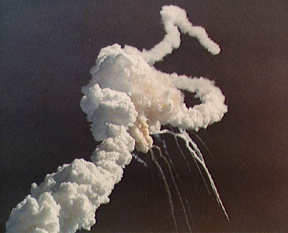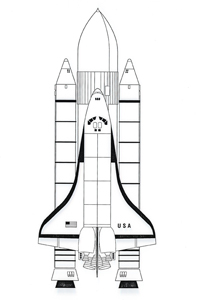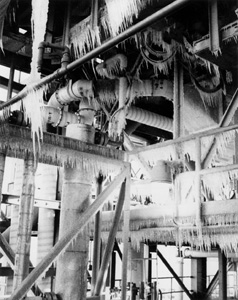| Space shuttle design flaws have had disastrous consequences for the American space program.
by Victoria Matthews

On January
28, 1986, the Challenger space shuttle exploded just 76
seconds after launch.
|
|
|
In 1981, the first space shuttle was
launched in the skies of Florida. The public watched in awe: it
launched like a rocket and flew like a spaceship. NASA thought this
machine would take the dream of space travel into the 21st century
and beyond. That is, until January 28th 1986: an unusually cold
morning with record low temperatures. After a series of delays,
the space shuttle Challenger launched at 11:38 AM. Just 76 seconds
later, that dream of space exploration took a tumble and the unthinkable
happened: the shuttle had exploded and all seven astronauts were
dead.
Twenty years later, it's now widely known that the Challenger explosion was caused by gas leaking into the joint of the right booster rocket. 'O' rings seal the sections of the rocket booster together and should have prevented the extremely hot rocket exhaust gases, produced at incredible pressure during launch, from getting into the rocket. But the rubber 'O' ring seal failed.
The greater tragedy is that engineer
Roger Boisjoly and his colleague Arnie Thompson had 'seen' the accident
coming. A year before the launch, they knew that the 'O' rings in
the solid rocket boosters could potentially fail under some circumstances
- and that if the primary and backup 'O' rings both failed, the
whole launch system could explode.

Space shuttle
diagram: Its main components are the spacecraft, 3 main
engines, a huge external tank and 2 solid rocket boosters.
|
But the design of the space shuttle itself was also to blame for the disaster. Space shuttles came about after the Apollo program and NASA was looking to cut costs. The Apollo program had cost 25 billion dollars - the equivalent of 135 billion dollars today - a cost of nearly 10 billion dollars per launch. The spacecrafts used for the Apollo missions were launched with rockets that could only be used once: they were hand-built and then discarded in pieces as its cargo climbed into orbit. It seemed clear that a less disposable way of traveling to space would be much more cost-efficient.
Space shuttles were seen as the way
forward: they were small, light could land like a plane and be launched
many times. But because of politics in the U.S. at the time, NASA
had to try hard to keep its funding. Many of the careful considerations
that had been made in the initial design had to be dropped to cut
costs. A major concession was to settle for solid rocket boosters
to save on research and development time, when the initial plan
was to use safer liquid booster rockets.
Restrictions were also imposed by the Air Force, whom NASA got support from to increase their political influence. The shuttle had to conform to the Air Force's size and weight requirements and they wanted the shuttle to be able to carry large satellites that the Air Force needed to launch. A heavier space shuttle than intended had to be designed and this required the shuttle to be positioned alongside the solid rocket boosters instead of above them. Now, the space shuttle risked being caught in the fireball if the rockets exploded during the launch.
Despite the changes that were made,
once completed, the space shuttle was deemed a reliable workhorse
and a superior way of traveling into space. Perhaps all the praise
made NASA overly confident, causing them to dismiss Boisjoly and
Thompson's advice the night before the launch. The engineers were
involved in a three-way teleconference to alert their managers that
launching in cold temperatures could affect the 'O' ring joint seals.
The managers of Morton Thiokol, who had manufactured the rockets,
decided that the problem wasn't serious enough to cancel the launch.
Their multimillion dollar contract was up for renewal and NASA had
a tight launch schedule to maintain. The launch had already been
delayed and if the shuttle didn't launch by February 1, some of
the science experiments and business arrangements regarding the
satellite would be jeopardized.

Ice on the launch pad: Temperatures in Florida were exceptionally low on January 28, 1986.
|
After the Challenger exploded, and
the presidential commission investigated the causes of the disaster,
it was clear that the wrong decision had been made that night. Many
design changes to the shuttle were planned and it was over two years
before the U.S. sent another manned flight to space. An escape system
was developed for future missions, and the 'O' rings were redesigned.
A heated layer was also added to the joints, preventing them from
getting too cold, and a third 'O' ring was added.
It was not the last disaster for NASA, but manned space exploration has persisted. In May 2006, space shuttle Discovery is due to launch. But as one engineer explained, keeping the shuttle up and running is like dealing with a patient in intensive care. The days of the space shuttle are numbered, and the remaining fleet will retire in the not too distant future.
|
